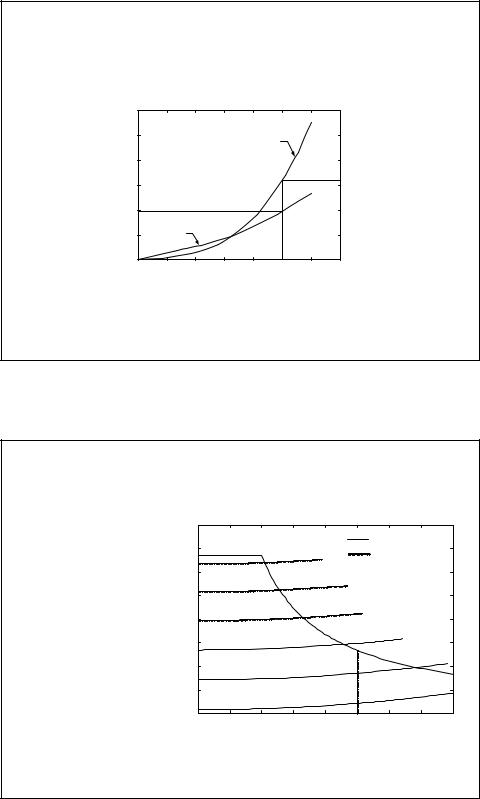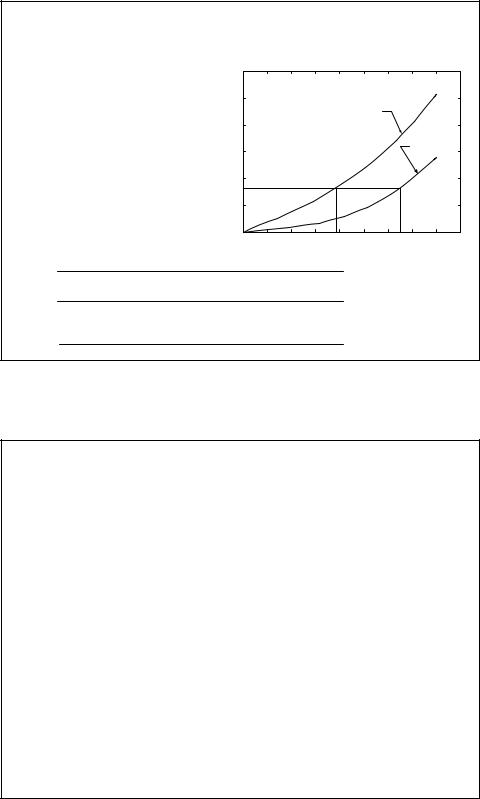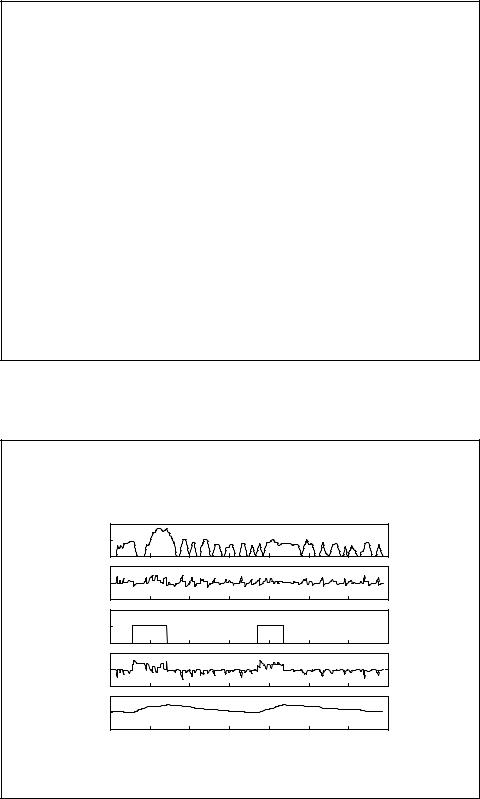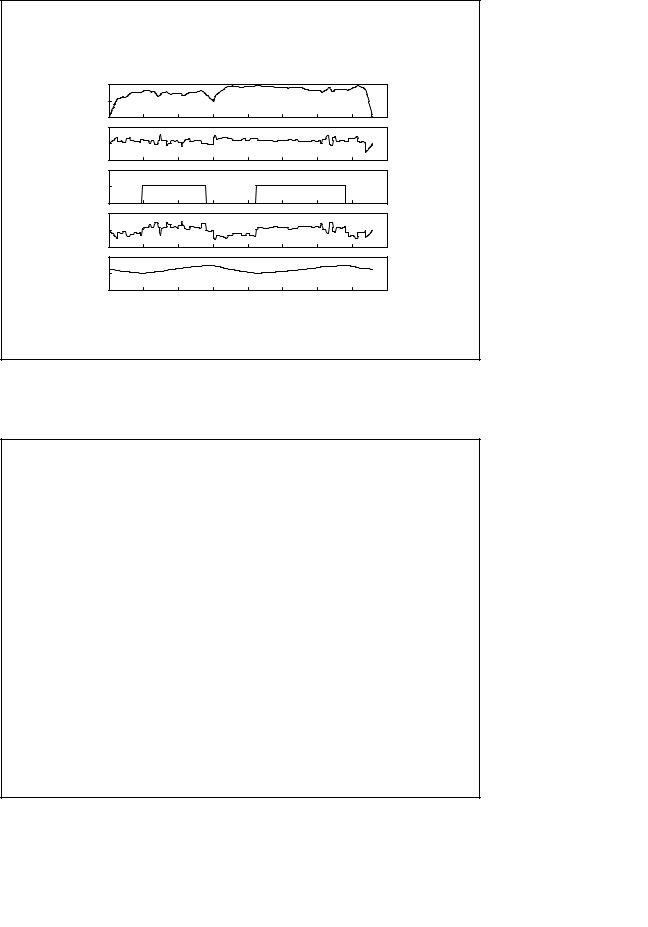
Chris_Mi_handout
.pdf
Vehicle Performance
•Acceleration: vehicle must be able to accelerate to certain speed within certain time limits. It is constrained by the traction motor rating and the power from I/G set and battery
•Gradeability: must be able to climb certain grade
•Maximum cruising speed
•Range
Control Strategy
•A control rule
–Preset in the vehicle controller
–Control the operation of each component
–Receive commands from the driver
–Receive the feedback from the drivetrain and components
•Many strategies available, typical are:
–Maximum SOC strategy
–Thermostat or Engine on-off strategy
8

Maximum SOC Strategy
•To meet the power demand by the driver and at the mean time, maintain high level SOC
–Suitable for stop-go driving patterns
–Military vehicles: carrying out mission is critical
–Guarantee high performance of vehicle
•Disadvantages
–When battery fully charged, vehicle enters engine alone mode. Engine will not operate efficiently
Typical Operation Modes
|
Max. traction motor power |
||
|
A |
|
|
Ppps |
|
|
|
|
|
B |
Ppps-cha |
|
|
|
|
Pe/g |
Pcom |
|
Pcom |
|
|
|
|
Vr |
|
|
Vehicle |
|
|
|
speed |
Pcom |
|
Pregen |
Pcom |
Pregen |
|
|
|
|
|
|
|
|
|
|
D |
|
Pb-mech |
Max. regenerative braking power |
|
|
C |
|
|
9

Control Diagram
|
|
|
|
|
|
Traction power |
|
|
Maximum |
|||||||
|
|
|
|
|
|
|
|
|||||||||
|
|
|
|
|
|
|
|
motor power |
||||||||
|
Braking power |
|
|
Command, Ptraction |
|
|
Pm-max Regenerative |
|||||||||
|
|
|
|
|
||||||||||||
|
command, Pbrake |
Traction? |
|
|
|
|
If Pbrake>Pm-max |
|
braking |
|
||||||
|
|
|
|
No |
|
No |
||||||||||
|
|
|
|
|
|
Yes |
|
|
|
|
||||||
Engine/generator |
|
|
|
Hybrid traction |
Yes |
|
|
Hybrid braking |
||||||||
|
|
|
|
|
||||||||||||
|
|
|
|
|
|
|||||||||||
|
|
|
|
|
|
|
||||||||||
Power, Pe/g |
Ptraction<Pe/g |
(eng./gen. + PPS) |
|
|
|
|
|
|
||||||||
|
|
|
|
|
|
No |
|
|
|
|
|
|
||||
|
|
|
|
|
|
|
|
|
|
|
|
|
|
|
||
SOC of PPS |
|
|
Yes |
|
|
Eng./gen. |
|
|
|
|
|
|
||||
|
|
|
|
|
|
|
|
|
|
|
||||||
|
|
|
|
|
|
|
|
|
||||||||
If SOC<SOPtop |
|
|
alone traction |
|
|
|
|
|
|
|||||||
|
|
|
|
|
|
No |
|
|
|
|
|
|
||||
|
|
|
|
|
|
|
|
|
|
|
|
|
|
|
||
|
|
|
|
Yes |
|
PPS |
|
|
|
|
|
|
|
|
|
|
|
|
|
|
|
|
|
|
|
|
|
|
|
|
|
||
|
|
|
|
|
|
charging |
|
|
|
|
|
|
|
|
|
|
Thermostat Control (Engine on-off)
•Engine is turned off when SOC reaches preset top limit
•Engine is on when SOC drops below its preset low limit
–Disadvantage is, if vehicle needs sudden demand but the SOC is at low, there may be a problem
10

Design of Series HEV
•Design and selection of major components:
–Traction motor
–Engine
–Generator
–Battery/energy storage
•Verify vehicle performance
–Acceleration
–Gradeability
–Maximum cruising
–Fuel economy and emissions
Design Example
• Specifications |
|
– Total mass |
1500kg |
– Rolling resistance coefficient |
0.01 |
– Aerodynamic drag coefficient |
0.3 |
– Frontal area |
2 m3 |
– Transmission efficiency |
0.9 |
• Performance
– Acceleration time (0 to 100km/h) |
10 sec |
– Maximum gradeability |
30% at low speed |
and 5% at 100km/h |
|
– Maximum speed |
160km/h |
11

Traction Motor
•Must be able to satisfy all vehicle performances such as acceleration, gradeability, etc.
•Motor power to overcome all resistance + ma
•Designed to be 82.5kW for the example
|
700 |
|
Torque |
|
|
|
|
|
|
140 |
|
|
|
|
|
|
|
|
|
X = 4 |
|
|
|||
|
600 |
|
|
|
|
|
|
|
120 |
|
||
|
|
|
|
|
|
|
|
|
|
|
||
Motor torque, N.m |
500 |
|
|
|
|
|
|
|
|
|
100 |
Motor power, kW |
400 |
|
|
|
|
|
Power |
|
|
80 |
|||
|
|
|
|
|
|
|
|
|
||||
300 |
|
|
|
|
|
|
|
|
|
60 |
||
200 |
|
|
|
|
|
|
|
|
|
40 |
||
|
|
|
|
|
|
|
|
|
|
|
||
|
100 |
|
|
|
|
|
|
|
|
|
20 |
|
|
0 |
0 |
500 |
1000 |
1500 |
2000 |
2500 3000 |
3500 |
4000 |
4500 |
0 |
|
|
|
5000 |
|
|||||||||
|
|
|
|
|
|
Motor speed, rpm |
|
|
|
|
|
|
Gear Ratio
•Vehicle reaches maximum speed when motor reaches maximum speed
–Motor maximum speed is 5000rpm
–Vehicle maximum speed is 160km/h or 44.4 m/s
–Radius is 0.28m
•Then gear ratio is 3.3
–5000rpm/60 sec * 2 pi * r = 44.4m/s * ig
12

Acceleration Performance
30 |
|
|
|
|
|
|
|
300 |
25 |
|
|
|
|
Distance |
|
250 |
|
|
|
|
|
|
|
|
||
20 |
|
|
|
|
|
|
|
200 |
15 |
|
|
|
|
|
|
|
150 |
10 |
|
|
|
|
|
|
|
100 |
5 |
|
Time |
|
|
|
|
|
50 |
0 |
0 |
20 |
40 |
60 |
80 |
100 |
120 |
140 |
|
|
|
|
Vehicle speed, km/h |
|
|
|
|
|
|
|
Gradeability |
|
|
|
|
|
|||||
|
|
|
8000 |
|
|
|
|
|
|
|
|
|
|
• |
46.6% at low |
N |
7000 |
|
|
|
=25 |
(46.6%) |
|
Tractive effort |
|
|
|
|
|
|
|
aerodynamic+ |
|
|
|||||||
|
|
|
|
|
o |
|
|
Resistance (rolling |
|
||||
|
speeds |
resistance, |
6000 |
|
|
|
|
=20o (36.4%) |
|
+ |
|
|
|
|
|
|
|
|
|
hill climbing) |
|
|
|||||
|
|
|
|
|
|
|
|
|
|
|
|||
|
|
and |
5000 |
|
|
|
|
|
|
|
|
|
|
• |
15% at 100 |
|
|
|
|
|
=15o (26.6%) |
|
|
|
|
||
effort |
4000 |
|
|
|
|
|
=10o (17.6%) |
|
|
||||
|
|
|
|
|
|
|
|
|
|
|
|
|
|
|
km/h |
Tractive |
3000 |
|
|
|
|
|
|
|
|
|
|
|
2000 |
|
|
|
|
|
|
|
=5o (8.75%) |
||||
|
|
|
1000 |
|
|
|
|
|
|
|
=0o |
(0%) |
|
|
|
|
0 |
0 |
20 |
40 |
60 |
80 |
100 |
120 |
140 |
160 |
|
Vehicle speed, km/h
13

Engine/Generator
•Highway driving: long time with constant speed
–Engine/generator must be able to supply sufficient power to support the speed
•Frequent stop-go pattern
–Must be able to maintain SOC of battery
•During Acceleration
–Total power from battery and I/G is needed to support acceleration
Design Example
14

Required Engine Power
•Constant Speed: on flat road and on 5% grade
•Different driving cycle: average power
•Therefore engine is 32.5kW
|
120 |
|
|
|
|
|
|
|
|
|
kW |
100 |
|
|
|
|
|
|
|
|
|
|
|
|
On 5% grade road |
|
|
|
|
|||
power, |
80 |
|
|
|
|
|
|
|
|
|
|
|
|
|
|
|
|
On flat road |
|
||
Engine |
60 |
|
|
|
|
|
|
|
||
|
|
|
|
|
|
|
|
|
||
|
|
|
|
|
|
|
|
|
|
|
|
40 |
|
|
|
|
|
|
|
|
|
|
32.5 |
|
|
|
|
|
|
|
|
|
|
20 |
|
|
|
|
|
|
|
|
|
|
00 |
20 |
40 |
60 |
80 |
100 |
120 |
140 |
160 |
180 |
|
|
|
|
Vehicle speed, km/h |
|
|
|
|||
Energy Storage System
•Power capacity
–To fully utilize the motor power capacity
–Ppps>Pmtor,max – Pe/g
–Example: 82.5/0.85 (eff) -32.5*0.9 eff = 67.8kW
•Energy Capacity
–Support the whole acceleration range when partially discharged
–2.5kWh (0.2 SOC change corresponding to 0.5kWh change in PPS energy)
–In battery alone, with maximum motor capacity, vehicle can run 109 seconds (2.5kWh*3600/82.5kW)
15

Fuel Consumption
•Engine is operated at 34.3% efficiency
•Fuel economy depends on driving cycle
•Fuel economy depends on control strategy
•Example vehicle:
–42.3 mpg FTP75 Urban Driving Cycle
–43.5 mpg FTP75 Highway Driving Cycle
FTP Urban Driving Cycle
100 |
Vehicle speed, km/h |
|
50 |
||
|
||
0 |
|
|
50 |
Motor power, kW |
|
0 |
||
|
-50 40
Engine power, kW
20
0
50
PPS power, kW
0
-50 2
1 |
|
Energy change in PPS, kW.h |
|
|
|
||
0 0 |
|
|
|
|
|||
200 |
400 |
600 |
800 |
1000 |
1200 |
1400 |
|
Time, Sec.
16

FTP75 Highway Driving Cycle
Summary
•HEVs can be designed to have series, parallel or complex configurations to overcome the cost/range problem in pure EVs
•Series HEVs convert energy twice, hence there may be more cost and efficiency disadvantages
•Series HEVs are suitable for most stop-go applications such as bus, delivery truck, commuter car, yard tractor, etc.
•Series HEVs can be controlled using either maximum battery SOC or thermostat (engine on-off) control
•The design of series includes sizing the ICE, motor, and energy storage device
•The performance of series HEVs can be simulated for standard driving cycles, which include maximum speed, acceleration, gradeability, etc.
17
